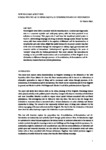New Belgrade After 1999: Spatial Violence as De-Socialisation, De-Romanisation, and De-Historisation
| dc.contributor.author | Bobic, N | |
| dc.date.accessioned | 2020-08-09T20:28:31Z | |
| dc.date.available | 2020-08-09T20:28:31Z | |
| dc.date.issued | 2016 | |
| dc.identifier.isbn | 1138687391 | |
| dc.identifier.isbn | 9781138687394 | |
| dc.identifier.uri | http://hdl.handle.net/10026.1/16147 | |
| dc.description.abstract |
New Belgrade after 1999 is associated with the transition from a socialist and single-party state to a consumer capitalist and multi-party system, these latter features perceived as indicators of democracy. This text asks if and how this transitional period points to NATO's 1999 bombing campaign still being in-operation through spatial violence by other means, with these means related to the negation of difference and the transformation of everyday life and social values. Might this spatial violence be even more coercive than that of the war as it manifests through the convergence of military, legal, governmental, and economic entities of international “redevelopment” agencies working in the name of “security” along with the Serbian government? The focus here is on the post-1999 transformation and re-modernisation of New Belgrade as an elimination of differference through processes of de-socialisation, de-Romanisation, and de-historisation connected with neo-liberal privatisation. | |
| dc.format.extent | 87-107 | |
| dc.language.iso | en | |
| dc.publisher | Routledge | |
| dc.relation.ispartof | Spatial Violence | |
| dc.subject | 33 Built Environment and Design | |
| dc.subject | 3301 Architecture | |
| dc.subject | Pediatric | |
| dc.subject | Violence Research | |
| dc.subject | Youth Violence | |
| dc.subject | 16 Peace, Justice and Strong Institutions | |
| dc.title | New Belgrade After 1999: Spatial Violence as De-Socialisation, De-Romanisation, and De-Historisation | |
| dc.type | chapter | |
| plymouth.publisher-url | https://www.taylorfrancis.com/chapters/edit/10.4324/9781315542324-6/new-belgrade-1999-spatial-violence-de-socialisation-de-romanisation-de-historisation-nikolina-bobic?context=ubx&refId=ee31e4a2-6df8-417e-8b41-451a4fc0702b | |
| plymouth.publication-status | Published online | |
| dc.identifier.doi | 10.4324/9781315542324 | |
| plymouth.organisational-group | /Plymouth | |
| plymouth.organisational-group | /Plymouth/Faculty of Arts, Humanities and Business | |
| plymouth.organisational-group | /Plymouth/REF 2021 Researchers by UoA | |
| plymouth.organisational-group | /Plymouth/REF 2021 Researchers by UoA/UoA13 Architecture, Built Environment and Planning | |
| plymouth.organisational-group | /Plymouth/Users by role | |
| plymouth.organisational-group | /Plymouth/Users by role/Academics | |
| dc.publisher.place | London | |
| dc.rights.embargoperiod | Not known | |
| rioxxterms.versionofrecord | 10.4324/9781315542324 | |
| rioxxterms.licenseref.uri | http://www.rioxx.net/licenses/all-rights-reserved | |
| rioxxterms.type | Book chapter |


